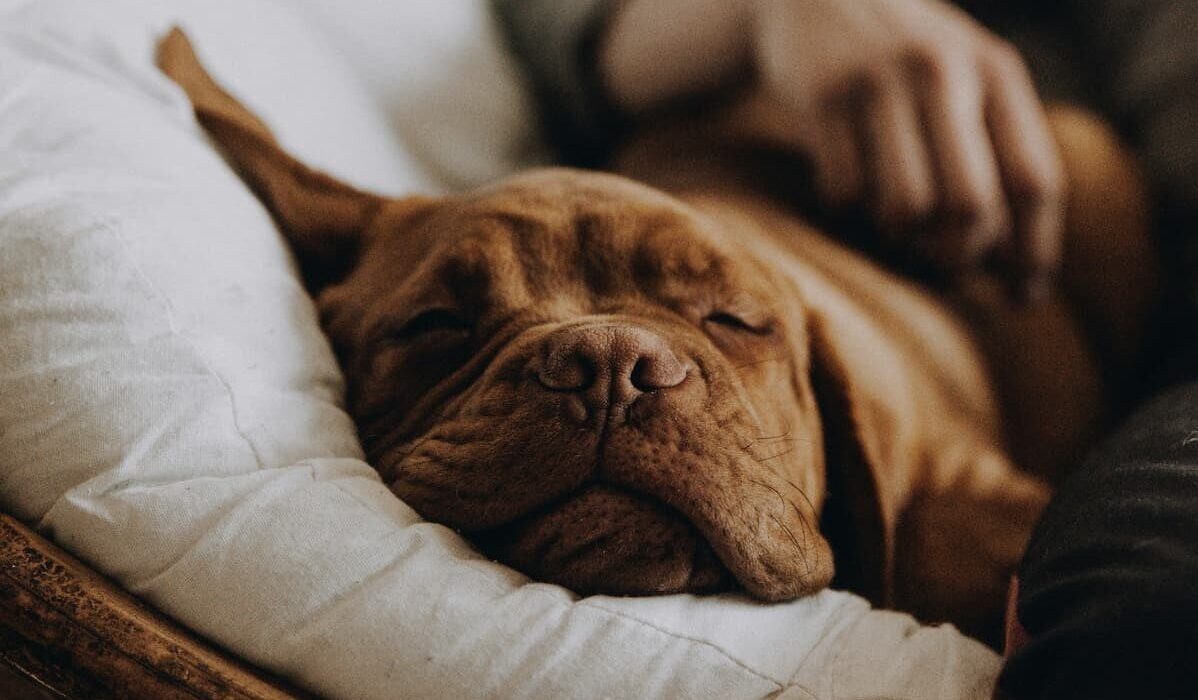Ever found yourself snuggled up warmly in bed, drifting away to dreamland, only to be rudely awakened by a sudden and frightening jolt?
We’re not alone in this shocking phenomenon — even our beloved canines occasionally face the perplexing phenomenon of seizures during their peaceful slumber.
Picture this: a starry night, a gentle breeze rustling the leaves, your loyal companion curled up by your side.
As you gaze upon your furry friend’s serene face, little do you know that underneath those closed eyelids, their dream state conceals a mysterious activity that occasionally threatens their tranquility.
These seizures, although rare, send shockwaves of worry through any dog parent’s heart, urging us to explore the fascinating science behind these nocturnal disturbances.
This article will uncover the reasons behind this condition.
Understanding Seizures in Sleeping Dogs
Seizures in dogs can be a distressing and alarming event for both the pet and the owner.
It’s even more puzzling when these seizures occur during sleep.
Many dog owners may wonder why their furry companions experience these episodes while resting peacefully.
Firstly, it’s important to understand that seizures during sleep can affect dogs of any age or breed.
While the exact cause may vary, there are several factors that can contribute to these episodes.
One possible explanation is idiopathic epilepsy, a condition characterized by recurring seizures with no identifiable underlying cause.
Idiopathic epilepsy is commonly observed in certain breeds, such as Border Collies, Retrievers, and Beagles.
Additionally, certain health conditions can trigger seizures in dogs during sleep.
These may include metabolic disorders, brain tumors, or infections.
It’s crucial to consult with a veterinarian to rule out any underlying medical issues that could be causing these seizures.
Your vet may recommend blood tests, brain imaging, or other diagnostic procedures to determine the root cause and guide effective treatment.
What Happens in a Dog’s Brain While They Sleep?
During normal sleep cycles, dogs undergo different stages, including REM (Rapid Eye Movement) sleep, which is similar to the dreaming phase in humans.
However, when a dog experiences a seizure, it disrupts their sleep pattern and can be a sign of an underlying sleep disorder.
When a dog experiences a seizure while sleeping, the underlying mechanism is quite fascinating.
During a seizure, an abnormal electrical activity occurs in the dog’s brain, causing a disruption in their neural pathways.
This disruption can lead to a variety of physical and behavioral changes.
The brain, being the complex organ that it is, undergoes several stages during a seizure episode in a dog’s sleep:
Aura: Similar to humans, dogs often experience an aura before the actual seizure occurs.
During this phase, you may notice your dog acting restless, disoriented, or exhibiting strange behaviors.
Paying attention to these signs can help you better anticipate and manage the seizure.
Tonic Phase: As the seizure progresses, your dog’s muscles may become stiff or rigid.
They might fall to the side or become paralyzed temporarily.
This phase can be distressing to witness, but it is essential to stay calm and ensure your pet’s safety by removing any nearby objects that could pose a risk of injury.
Clonic Phase: Following the tonic phase, the convulsive stage begins.
During this phase, your dog’s muscles may twitch, jerk, or spasm involuntarily.
It is important to remember that your dog is not in pain during a seizure, although it may look unsettling.
Keeping a close eye on their breathing and making sure their airway remains clear is crucial until the seizure subsides.
Potential Triggers of Seizures in Dogs during Sleep
So why do dogs have seizures in their sleep?
Well, there isn’t a one-size-fits-all answer, as numerous factors can contribute to these unsettling nighttime episodes:
1. Epilepsy: Just like humans, dogs can suffer from epilepsy, a neurological disorder characterized by recurrent seizures.
These seizures can occur during sleep or while the dog is awake.
While the exact cause of epilepsy in dogs is often unknown, certain breeds may have a genetic predisposition to the condition.
Regular veterinary check-ups are crucial for early diagnosis and to discuss appropriate treatment options.
2. Metabolic Imbalances: Dogs experiencing metabolic imbalances, such as low blood sugar, low calcium levels, or liver disease, are at an increased risk of seizures during sleep.
These imbalances disrupt the normal electrical activity in the brain and can trigger seizures.
It’s important to maintain a balanced and nutritious diet for your furry companion and promptly address any underlying health issues that may contribute to these imbalances.
3. Environmental Factors: Dogs are sensitive creatures, and their seizures can be triggered by various environmental factors during sleep.
Loud noises, extreme temperatures, exposure to toxic substances, or even certain medications can induce seizures.
Creating a Safe and Calming Environment for Dogs Prone to Seizures
A good night’s sleep is essential for dogs, just like it is for humans.
However, for dogs prone to seizures, bedtime can be a bit more challenging.
It’s important for dog owners to understand why seizures occur in a dog’s sleep and how to create a safe and calming environment to minimize the risk and discomfort for our furry friends.
To ensure a safe and calming environment for dogs prone to seizures, there are several steps you can take.
First and foremost, it’s crucial to establish a bedtime routine that promotes relaxation and helps your dog wind down.
Consider incorporating activities such as a light walk, gentle playtime, or some quiet bonding time before bed.
Creating a predictable routine can signal to your dog that it’s time to relax and settle down for the night.
Once you’ve established a bedtime routine, it’s important to make your dog’s sleep environment as safe and comfortable as possible.
Some suggestions include:
– Providing a cozy and comfortable bed or crate for your dog to sleep in.
This will give them a sense of security and a designated space for relaxation.
– Ensuring the sleeping area is free from any potential hazards, such as sharp objects, loose wires, or toxic plants.
Dogs prone to seizures may experience disorientation or loss of balance during an episode, so it’s crucial to minimize the risk of injury.
– Keeping the room at a comfortable temperature to promote deep and restful sleep.
Just like humans, dogs can become restless if they are too hot or too cold during the night.
– Minimizing noise and distractions in the sleeping area.
Consider using white noise machines or calming music to drown out any disruptive sounds that might disturb your dog’s sleep.
By creating a safe and calming environment for dogs prone to seizures, we can help them get the good night’s sleep they deserve.
Remember, it’s important to consult with your veterinarian if your dog experiences seizures or any other concerning symptoms during sleep.
They can provide valuable guidance and develop a personalized plan to keep your furry friend happy, healthy, and well-rested.
Recognizing the Signs of Seizures and When to Seek Veterinary Care
Seizures can be a frightening experience for both dogs and their owners.
As such, it is crucial that you understand the causes and recognize the signs of a seizure when seeking veterinary care.
Potential reasons for nocturnal seizures:
Epilepsy: Just like humans, dogs can have epilepsy, a neurological disorder characterized by recurrent seizures.
These seizures can occur at any time, including during sleep.
Sleep-wake cycle disturbances: Dogs, especially puppies, can experience sleep disruptions or altered sleep patterns, leading to an increased chance of seizures during sleep.
Encephalitis or brain tumors: In some cases, seizures during sleep can indicate underlying issues such as inflammation of the brain or the presence of tumors.
These conditions should be evaluated by a veterinarian.
Seizures can manifest in various ways, but some common signs to look out for include:
- Uncontrollable shaking or trembling
- Loss of consciousness
- Drooling or foaming at the mouth
- Unusual vocalizations
- Rigid or jerking body movements
If your dog experiences seizures or shows any of these signs, it’s important to remain calm and keep them safe during the episode.
Here are some steps to take:
- Clear the immediate area to prevent your dog from accidentally injuring themselves.
- Avoid putting your hands near your dog’s mouth, as they may unintentionally bite down during a seizure.
- Note the duration of the seizure, as well as any specific details or behaviors your dog exhibits, to provide important information to your vet.
- After the seizure, contact your veterinarian who will guide you in assessing your dog’s condition and determining the next steps for their health.
When it comes to managing seizures in dogs during sleep, there are various options available.
Medications, such as antiepileptic drugs, may be prescribed to control and reduce the frequency of seizures.
Your vet may also recommend changes to your dog’s diet, lifestyle, or environment to provide them with a safe and stress-free sleeping environment.
Remember, each dog is unique, and what works for one might not work for another.
Working closely with your veterinarian can help you develop a personalized plan to support your furry friend through these episodes.
FAQ
Q: What exactly happens when dogs have seizures during sleep?
A: During a seizure, a dog’s brain activity becomes abnormal, resulting in involuntary muscle spasms, convulsions, or other abnormal behaviors.
When these seizures occur specifically during sleep, it means that something is triggering these abnormal brain signals while the dog is in a state of rest.
Q: Is it common for dogs to have seizures in their sleep?
A: While it may not be a daily occurrence for every pup, seizures during sleep are not entirely uncommon in dogs.
It’s important to note that some breeds are more predisposed to seizures than others.
So, it’s always good to be aware of your dog’s specific risks when discussing potential health concerns with your veterinarian.
Q: What might be the causes behind these seizures during sleep?
A: Ah, the million-dollar question!
There could be several reasons why a dog might experience seizures during sleep.
One possible explanation is epilepsy, a chronic condition that affects the brain’s normal electrical activity.
In other cases, seizures during sleep might be caused by brain tumors, infections, metabolic disorders, toxins, or even trauma.
It’s truly a complex puzzle that requires a thorough examination to determine the root cause.
Q: Can these seizures be harmful or life-threatening for dogs?
A: Seizures themselves can be quite distressing for both dogs and their owners, but it’s important to remember that while witnessing a seizure can be frightening, they are not immediately life-threatening for your furry friend.
However, recurring or severe seizures can have long-term consequences and should always be evaluated by a veterinarian to ensure the well-being of your pet.
Q: How can dog owners help their furry pals if they have seizures during sleep?
A: First and foremost, providing a safe and comfortable space for your dog to sleep is crucial.
Make sure to clear any hazards that may be nearby, such as sharp objects or furniture with sharp edges.
Additionally, keeping track of seizure frequency, duration, and any potential factors that may trigger them can be helpful in determining the best course of action.
Remember to consult with your veterinarian to discuss your findings and explore available treatment options.
Q: Can medications or treatments help reduce or prevent seizures for dogs while they sleep?
A: Absolutely!
If your dog is experiencing frequent or severe seizures during sleep, your veterinarian may prescribe medications, such as anticonvulsants, to help manage and control these episodes.
However, each case is unique, and it is essential to work closely with a professional to tailor the treatment to your beloved pup’s specific needs.
Q: Is there anything else dog owners should know about dog’s seizures during sleep?
A: Perhaps the most important thing is not to panic if you witness your furry companion having a seizure during sleep.
Stay calm, keep your pet safe, and record all relevant information about the episodes.
By partnering with a trusted veterinarian and providing the necessary support to your dog, you can navigate this challenge together and give your pup the loving care they deserve.
Remember, if you ever have concerns about your dog’s health, it’s always a good idea to reach out to your veterinarian for guidance.
The Bottom Line
While witnessing our beloved pups experiencing seizures can be distressing, it’s important to remember that not all seizures are life-threatening.
Some may simply be temporary disruptions in their dreamscapes.
However, it’s crucial to consult with a veterinarian if your dog experiences recurring seizures, as they can provide the necessary guidance and diagnosis.
By understanding the potential reasons behind these nocturnal convulsions, we can offer comfort and proper care to our canine companions.
Creating a safe sleeping environment, reducing stress levels, and maintaining a healthy lifestyle are key steps in promoting their well-being.
So next time you find Rover thrashing about in the midst of slumber, rest assured knowing that he is not the only pooch experiencing these baffling sleep-time episodes.
Always be sure to give your furry friend an extra dose of love and reassurance.














